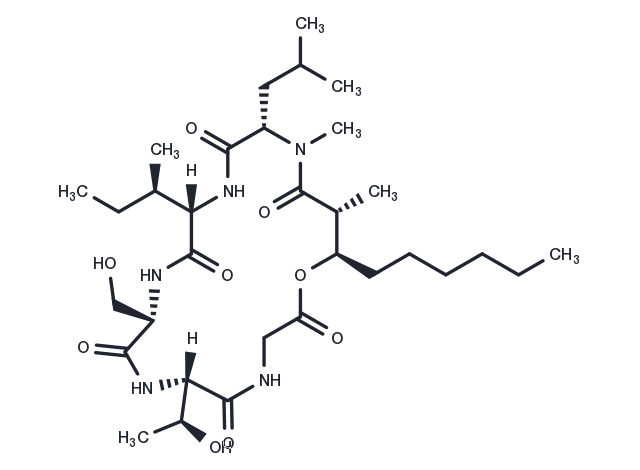keep away from moisture
Powder: -20°C for 3 years | In solvent: -80°C for 1 year

Globomycin is a lipopeptide antibiotic and an inhibitor of signal peptidase II (LspA). It inhibits the processing of the prolipoprotein by binding irreversibly to the peptidase.

| Pack Size | Availability | Price/USD | Quantity |
|---|---|---|---|
| 100 mg | Inquiry | Inquiry | |
| 500 mg | Inquiry | Inquiry |
| Description | Globomycin is a lipopeptide antibiotic and an inhibitor of signal peptidase II (LspA). It inhibits the processing of the prolipoprotein by binding irreversibly to the peptidase. |
| In vitro | Globomycin is capable of inhibiting the growth of S. melliferum. The MICs are 12.5 μM for strain B88 and 6.25 μM for strain BC3. Globomycin can interfere with the processing of bacterial lipoproteins by inhibition of signal peptidase II in gracilicutes (Gram-negative eubacteria) and firmicutes (Gram-positive eubacteria) [1]. In B. diminuta DS010 cells, in the Globomycin-treated cultures, most of the organophosphate hydrolase (OPH) accumulates in the cytoplasmic fraction in an unprocessed form. This is in contrast with the untreated cells where very little precursor was detectable. Moreover, there is substantially less mature OPH detectable in the membrane fraction following Globomycin treatment [2]. |
| Molecular Weight | 655.834 |
| Formula | C32H57N5O9 |
| CAS No. | 67076-74-8 |
keep away from moisture
Powder: -20°C for 3 years | In solvent: -80°C for 1 year
You can also refer to dose conversion for different animals. More
bottom
Please see Inhibitor Handling Instructions for more frequently ask questions. Topics include: how to prepare stock solutions, how to store products, and cautions on cell-based assays & animal experiments, etc.
Globomycin 67076-74-8 Others inhibitor inhibit
